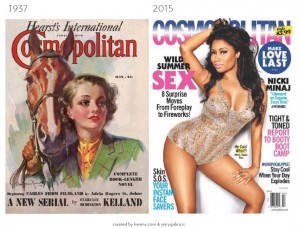Time Period Matters
It is human nature to assume that our current perceptions are real and right. But ‘real and right’ is a matter of being situated in a particular time period in a particular part of the world.
Two recent occurrences brought the idea of ‘time period matters’ to the top of my mind. The first was the Medium post by Karen X. Cheng and Jerry Gabra showing how magazine covers have changed over time, and the second was a discussion in my Leadership Communication class about how leadership theories morph over time.
Things we as a culture hold true today are not things other humans held true in the past nor will necessarily hold true in the future. Intellectually, that is an easy concept to grasp. The problem is that we don’t hold this concept top of mind when we are communicating with others. The ‘real and right’ perspective is problematic because is narrows our listening of others, limiting our ability to find commonality and get along peacefully. Our perspective can be vastly broadened when we realize that real and right is conditional.
The Evolution of Magazine Covers was a recent Medium post that exemplifies that time period matters. The display of magazine covers for publications ranging from Cosmopolitan and GQ to the New Yorker and National Geographic showed just how drastically our ‘real and right’ has changed over time.
The percentage of female body parts exposed increases significantly, and the hairstyles change. The amount of text on the cover of National Geographic decreases, and the language becomes much less scientific and more colloquial. The headlines on the magazines reveal what was top of mind in that given time period. The article dubs it, “survival of the fittest, capitalist edition,” but it is also a reflection of what our society deems important and appropriate. ‘Right and real’ changes over time, just like the magazine covers.
Teaching Leadership Communication at San Francisco State is awesome because every class has students from every walk of life, bring together many varying perspectives. We recently discussed how leadership theories, and I could hear the judgment in students’ voices as they commented on older theories centered on a person’s inherent physical traits. The indignant sentiment expressed was, “Of course it is not true that a large person with a deep voice is naturally a better leader than a small person with a high-pitched voice.” Not true? Not true when? Not true where? In our time, in our place, we think that judging leaders on their physical traits is sexist and racist. But in past time, this was ‘real and right’ for a group of people. This brings up questions like, what changed? At what point did that cultural moral compass shift, and why? By asking these types of questions, we can gain a deeper understanding for the transience of real and right.
Seeing how others thought differently in the past helps us to realize that how we think and act now may seem totally absurd to another people in another time. Springboarding from change over time, we can apply the same realization to spatial, cultural, and social differences. Even our own perceptions, which we often perceive as a fixed component of our character, are really quite malleable. By acknowledging that our ‘real and right’ is not permanent, not pervasive, we can have a more open mind. With a more open mind, we have a broader listening of others. When someone says something outside of our ‘real and right’ zone, we won’t immediately dismiss it as wrong. We might consider their opinion and listen respectfully, even if we disagree in that spatial and temporal moment.

